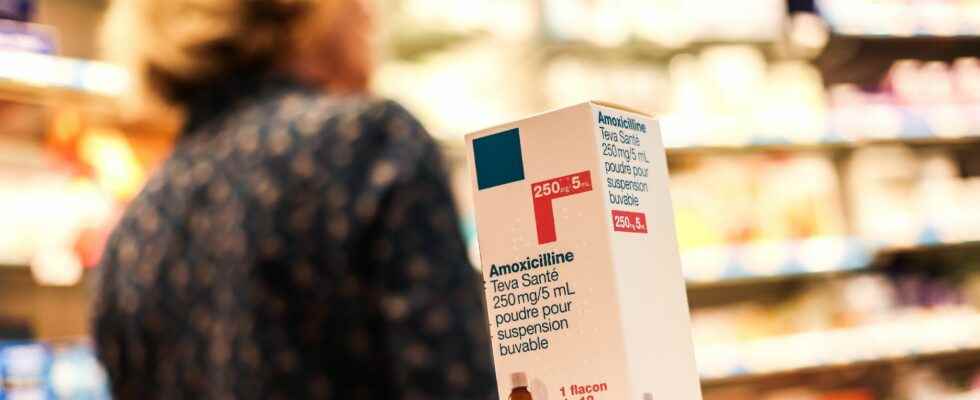In the heart of the 6th arrondissement of Paris, in the Saint-Michel district, a pharmacy manufactures the most prescribed antibiotic in France, which is currently in short supply: amoxicillin. For three weeks, a routine has settled in the laboratory of this pharmacy. “We run the production about two hours a day,” says Rachida Elhssaini, the preparatory manager. Equipped with overshoes, a blouse and an FFP2 mask, a dozen people are busy. On one side, four assistants are busy weighing the raw amoxicillin, to the nearest milligram, a sort of white powder.
Then, it must be introduced into the capsules by hand, packaged in jars and checked. “We have pallets on which we manufacture in series of 300 capsules, which represents 20 patient treatments”, explains Rachida Elhssaini. “Out of four people, each one does a task and it goes quickly. In three minutes the process for 300 capsules is completed”. On the other side, as many people are working to distribute the pots according to the prescriptions, while waiting for a courier to come and collect them.
From this Parisian pharmacy, 9,000 capsules come out every day, the equivalent of 600 treatments. Each pot contains 15 capsules, the equivalent of an antibiotic treatment to be taken three times a day for five days. In her 22-year career, Rachida Elhssaini had never seen her laboratory’s production line “ignite” to such an extent. “It’s our job to unpack specialties to put them in the dosage, especially for children…”, she explains. “But we have never had to deal with such great tensions over antibiotics for children”.
A process recommended by the ANSM
Since December 29, pharmacies that can are authorized to manufacture amoxicillin, on recommendation of the National Medicines Agency (ANSM). The agency recognizes “the strong tensions in the supply of amoxicillin-based drugs, mainly in drinkable suspensions in vials dosed at 125 mg / 5 ml and 250 mg / 5 ml mainly prescribed on an outpatient basis in children”.
“This is the first time that the ANSM has explicitly asked us to produce a drug”, points out Fabien Bruno, incumbent pharmacist in this pharmacy in the 6th arrondissement of Paris. It has already happened that we manufacture magistral preparations of breakthrough drugs, but by working with doctors. There, the ANSM called us straight out to ask us…” The institution has, moreover, set a price, on the basis of recommendations, for these laboratory pharmacies, so that they do not exceed understanding of the price.”The price of a jar is set at 18 euros for pharmacies, which means that we sell them around 12 euros,” explains Fabien Bruno. “But we don’t do that for the money. If we win 1 euro on each lot, it’s the end of the world”.
In total, forty-three pharmacies in France, with a laboratory that meets standards, now manufacture the drug. Enough to replenish at least the stocks of pharmacists in France. “We limit the distribution to ten jars per pharmacy per day”, underlines Rachida Elhssaini. “We try to manufacture some in advance because otherwise the whole process until delivery takes between 24 and 48 hours, but for an antibiotic you have to go quickly, otherwise it is useless”.
“Fortunately they are there to offer a solution”, breathes Philippe Besset, president of the Federation of Pharmaceutical Unions of France (FSPF). “It will not solve the problem but it is a useful troubleshooting solution for many patients”, he believes. A troubleshooting that it would be good to apply to antibiotic formulas for adults according to him. “We are in discussion with the Ministry of Health so that it authorizes pharmacists to manufacture amoxicillin in 500 mg / 5, because the shortage becomes, there too, very heavy “.
Lagging industrialists
Contrary to what one might think, the raw material for amoxicillin is not lacking. “We get our supplies from Spain,” says Fabien Bruno. “We have as many as we want”. So why can’t manufacturers manage to produce, in particular amoxicillin, while pharmacies and their small production lines manage to do so?
“The pharmaceutical network comes to the aid of manufacturers who are not able to do their job”, annoys at first Pierre-Olivier Variot, pharmacist in Plombières-lès-Dijon (Côte d’Or), and president of the Union of Community Pharmacists (USPO). But the bottom line is that “the demand is increased compared to the last two years when the pandemic made us wear the mask, which protected us from a lot of infections”, he notes. And to add: “it is also because other countries pay drug manufacturers better than France, which is not an attractive market and therefore comes after”. Aware of the problem and plagued by as many shortages as France, the German Minister of Health, Karl Lauterbach, authorized health insurance funds in early January to buy certain drugs from manufacturers at 50% more cost. The aim is to bring suppliers back to the German market. In France, the subject has been launched but does not seem to be unanimous.
According to the Ministry of Health, the shortages affecting France on amoxicillin should last another two months, and end in early March. “It takes time for the industrial production chains to get back on track,” says Philippe Besset. “The process is much more restrictive than for pharmacies”. In the meantime, Fabien Bruno ensures that his pharmacy and 40 others (among the 43) can still greatly increase in power on the production of amoxicillin. “For now, we have opened a production line, while we have four,” he says, although the situation is beginning to worry him. “We have known shortages of medicines for years, but it has never been at this level. Today, we are on shortages of three major products, namely corticosteroids, antibiotics and painkillers,” he concludes.
